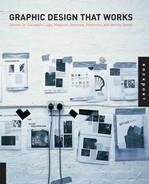
Job:12-84823 Title:RP-Graphic Design That Works (LDW)
175# Dtp:120/163 Page:18
Text (DS)
United
Today:
The present logo
While the United logo today is instantly recognizable worldwide, it under-
went a number of distinct changes before reaching its present form.
the evolution of a logo
1926-1933:
Each of United’s four
predecessor companies
had its own logo.
When United became
the management
company for those
carriers, it established
a bar-and-circle logo
with the bar containing
the words “United
Airlines” and the circle
housing each of the
four carrier’s logos.
1934:
The bar-and-circle logo
is modified. The circle
now contains a map of
the United States
inscribed with lines
denoting air routes.
1934-1940:
With no standards
manual to guide usage,
logo designs flourish.
Each one varies radically
from the others.
1936:
In an attempt to
standardize its logo, the
company adopts a red,
white, and blue shield.
Graphic Design That Works
18
010-025 84823 10/12/05 1:50 PM Page 18

Job:12-84823 Title:RP-Graphic Design That Works (LDW)
175# Dtp:120/163 Page:19
Text (DS)
DW)
ge:18
1940s:
Variations of the shield logo appear. In some cases
the company’s name appears at the top of the
shield; in others, centered below a star. In still oth-
ers, the shield is stretched, slanted, and even
sprouts wings.
1992:
After surveying customers, United determines it
needs a more elegant, understated image with
international appeal. The design firm CKS Partners
retains the U symbol but replaces Saul Bass’s sans
serif logotype with a more traditional serif face.
1997:
As part of a new
branding campaign,
Pentagram Design
updates the United logo.
It introduces new,
cropped versions of the
U symbol, creates a
bolder typeface for the
company’s name, and
drops the word “airlines”
from the logotype.
1960s:
Though not an official
logo, this slanted spire,
created by designer
Raymond Loewy, is used
on United’s aircraft tails
and begins to replace
the shield. Later, the
bold, sans serif typeface
used to spell out
United’s name is
replaced by the more
delicate Bookman
typeface.
So recognizable has the mark become that the company
encourages its designers to incorporate the logo’s U shape and
68-degree tilt into everything from navigational buttons on the
company website to the shape of the airline’s coffee cups.
1973:
United commissions the
designer Saul Bass to
develop a logo that will
convey leadership and
innovation in air travel.
The result is a stylized
red and blue U symbol—
later nicknamed “the
tulip”—and a custom
logotype featuring bold,
sans serif letters.
1998:
To distinguish different classes of service within the
airline, Pentagram Design develops a new color
scheme. Here, the company’s name appears in black,
while the name of the services appear in gray.
1970:
The shield logo all but
disappears. Without a
new logo, United’s iden-
tity becomes tied to its
“Fly the friendly skies”
slogan.
Mid-1980s:
Variations of
Saul Bass’s design
appear. In some cases,
the word “airlines” is
dropped; in others,
letters are squeezed
together. Occasionally,
the official logotype is
scrapped altogether,
replaced by the
company’s name
set in Bookman.
1946-1958:
This slanted version of
the shield logo becomes
the most commonly and
consistently used.
19
010-025 84823 10/12/05 1:50 PM Page 19
..................Content has been hidden....................
You can't read the all page of ebook, please click here login for view all page.
